#orthacanthus
Text
Daily fish fact #465
Orthacanthus!

This extinct shark species grew to be around 3 meters (10~ feet) and inhabited swamps and other freshwater habitats! They had a spike on their head, which is suspected to have been used for protection.
#its been over 100 facts since the last extinct fish! lets change that!#fish#fishfact#fish facts#fishblr#shark#sharks#biology#zoology#paleontology#orthacanthus
222 notes
·
View notes
Text
Mermay 2022: Paleontology Infuenced Merfolk
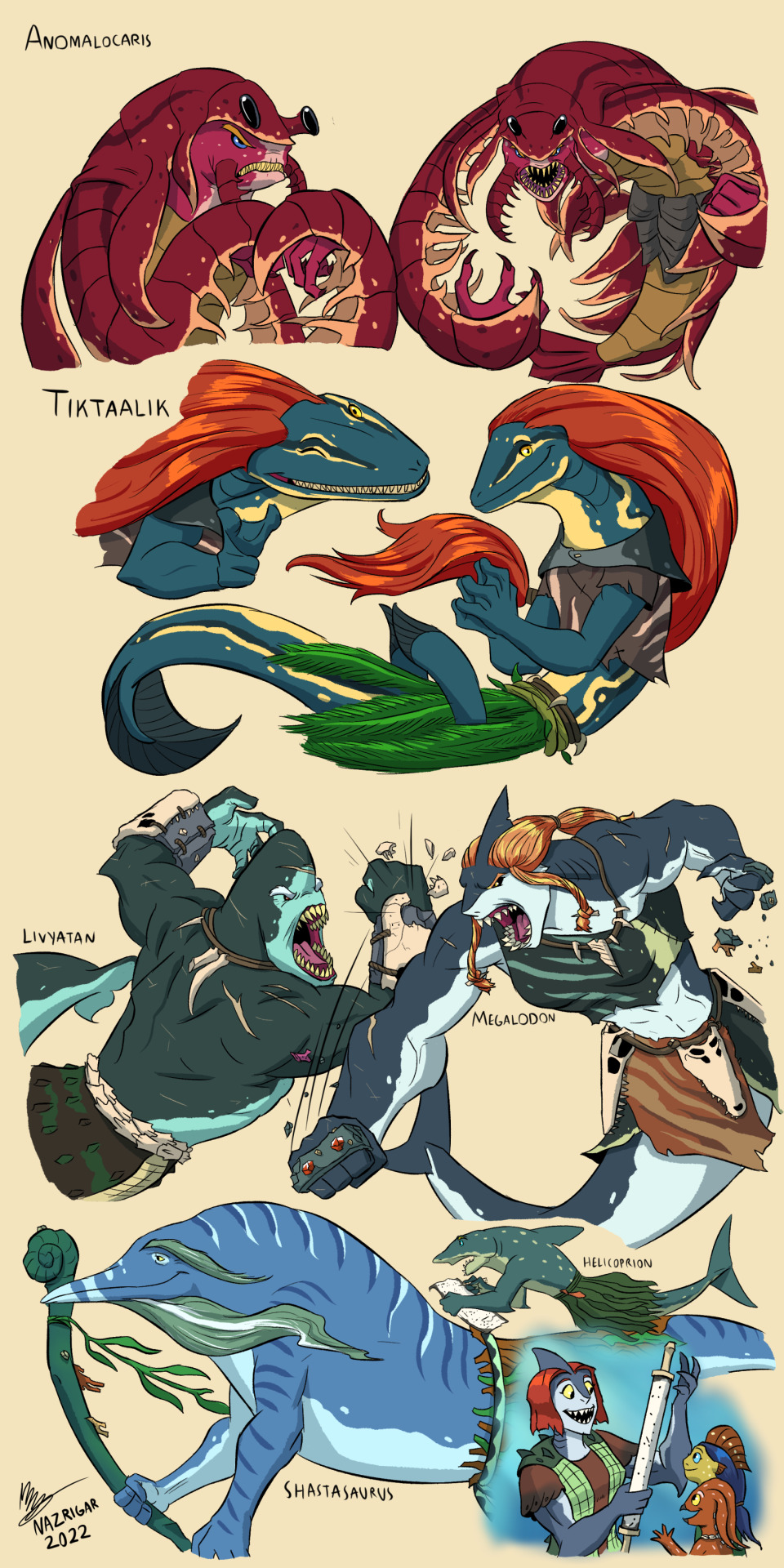
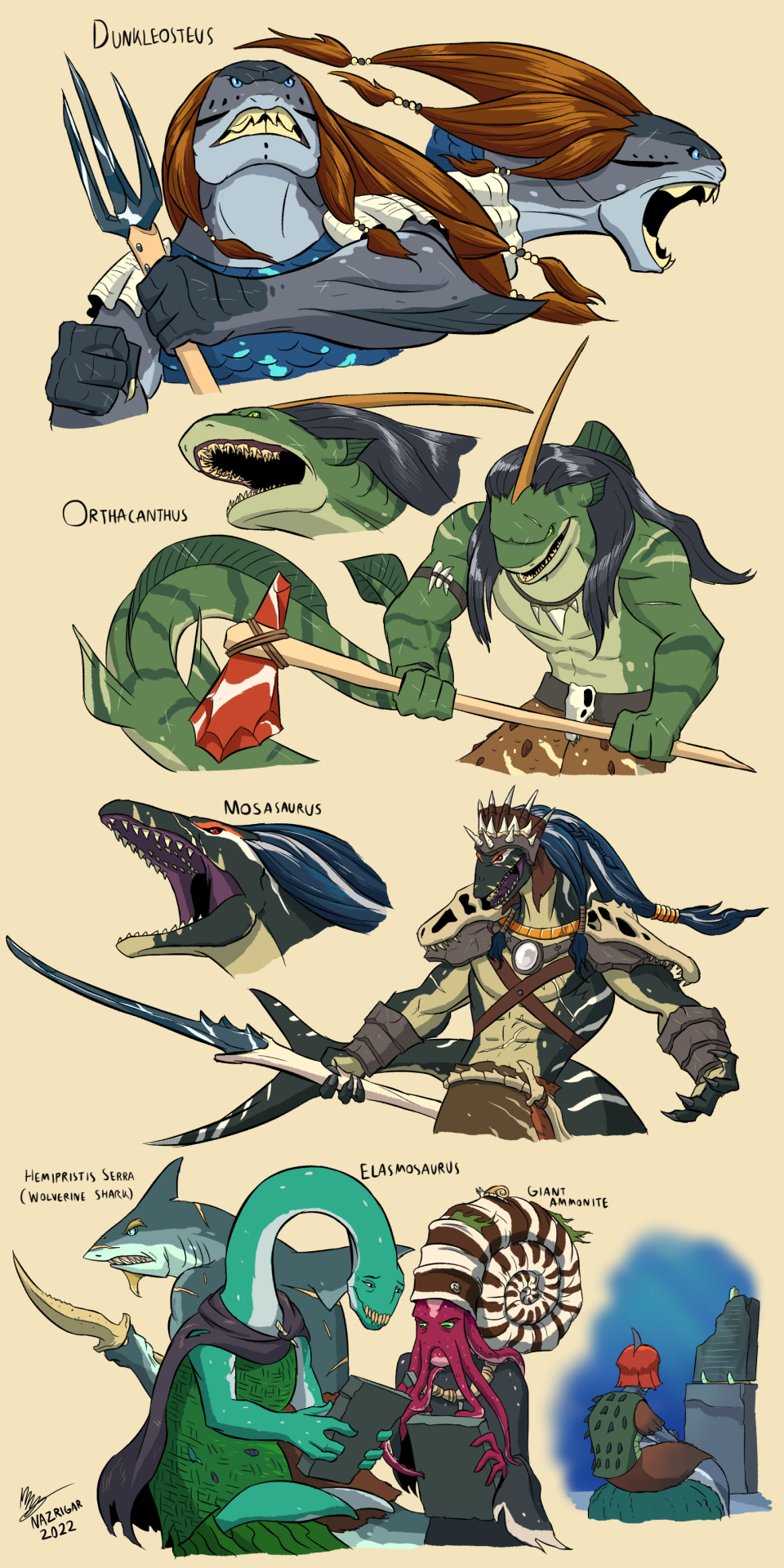
Part 1
Part 2
Part 3
The final batch of drawings for Mermay! Thank you all so, so much for the response. Never in my wildest dreams would I have thought this series to be so well liked and successful on so many of my social media platforms.
I felt like for the final batch, I wanted to explore how paleontology influenced merfolk would look like, and how they influence ‘modern’ merfolk. (Prehistoric Planet probably influenced my decision haha)
These are the lads and lasses that help found the formation for merfolk culture, from first-of-the-firsts like the Anomalocaris and the Tiktaalik to true giants of the sea, like Shastasaurus, Livyatan and Megalodon. The Megalodon is Kara’s personal idol. (Kara’s the great white shark featured in all previous batches, here she’s teaching kids how cool history is!)
The most important figure here in Merfolk history is actually the Mosasaurus, AKA The Ocean Lord. He was a Barbarian King who hated landlubbers and was the sworn nemesis of "The Tyrant King”. He’s revered by modern Merfolk for his combination of strength, cunning, battle prowess and magnetic personality.
However, a tablet written during his time paints a different picture of the Ocean Lord: One of an arrogant, bloodthirsty ruler whose conquering ways and obsessive hatred of the landlubbers did more harm long term than anyone could have imagined.
A shout out to @miuzes , who motivated and helped me with tips all throughout the way. Another shout out @florence-is-gay / @legendary-disaster , who made fan art of Kara!. I’m STILL freaking out! Never would I expect I’d get fan art for this! :D
#mermay#mermay 2022#mermaid#mosasaurus#tiktaalik#megalodon#anomalocaris#livyatan#dunkleosteus#orthacanthus#shastasaurus#ammonite#wolverine shark#elasmosaurus#merpeople#merfolk#mermaids#fantasy#creature design#character design#my art#nazrigart#paleontology#marine biology
1K notes
·
View notes
Photo

Ancient Elasmobranchii
#carcharocles megalodon#megalodon#ctenacanthus amblyxiphias#ctenacanthus#falcactus falcactus#falcactus#Stethacanthus altonensis#Stethacanthus#Ironing-Board Shark#aquilolamma milarcae#eagle shark#orthacanthus#paleoart#ancient sharks#prehistoric#prehistoric art#shark#sharks#my art#q
134 notes
·
View notes
Text





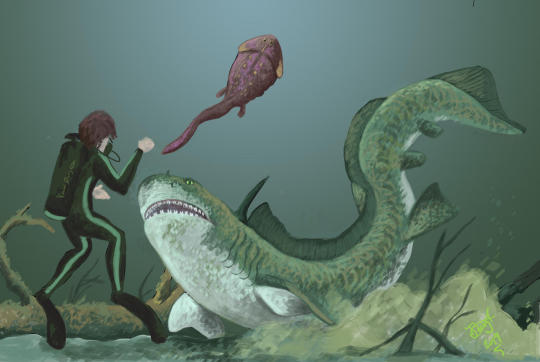

Orthacanthus is an extinct genus of fresh-water xenacanthid shark which lived throughout the rivers, swamps, lakes, and bayous of what is now Eurasia and North America during the Emsian of the early Devonian to the Carnian of the Late Triassic some 407 to 227 million years ago. The first remains of orthacanthus consisting of several neural spines and vertebrae were unearthed from carboniferous rocks in Great Britain by Dr. Louis Agassiz in 1836 which he described as a species of primitive skate. Several more spines and teeth would be found throughout England, Scotland, Wales, Ireland, Nova Scotia Canada, and Ohio USA but were variously assigned to Pleuracanthus and Diplodus. In 1848 a well preserved full body impression of an animal was unearthed near Ruppelsdorf Germany by Dr. Goldfuss who described and named the specimen as Xenacanthus. However additional findings in texas of both Orthacanthus and xenacanthus in the 1880s showed a marked distinction in both size and morphology between the two taxa. These prompted additional studies which showed the German impression to be of orthacanthus and that Dittodus, Didymodus, Diplodus to be synoynomous with orthacanthus and that pleuracanthus was already an established genus of beetles as such all previous pleuracathus fossils are now considered orthacanthus. Today 11 species of Orthacanthus are considered valid: O. gibbosus, O. arcuatus, O. buxieri, O. compressus, O. donnelljohnsi, O. gracilis, O. milleri, O. minor, O. platypternus, O. pustulosus, & O. texensis. Reaching upwards of 10ft (3m) in length, Orthacanthus had a number of features that distinguished it from modern sharks including a ribbon like dorsal fin which ran down nearly the entirety of the animals back, and had paired pectoral & pelvic fins and 4 anal fins. A distinctive spine projected from the back of the head which is speculated to have been venomous, perhaps in a similar manner to a sting ray or chimera. As a large aquatic predator Orthacanthus would have fed upon boney fish, placoderms, sharks and other cartilaginous fish, amphibians, aquatic reptiles, synapsids, and various invertebrates. Interestingly orthacanthus seems to have been a highly adaptable organism with smaller and younger individuals living in shallower waters like ponds, rivers, and streams, while larger older individuals dwelled in freshwater lakes, brackish swamps/ deltas, and even coastal waters.
Art by the following creators:
Orthacanthus: Christopher DiPiazza
http://prehistoricbeastoftheweek.blogspot.com/2013/08/orthacanthus-prehistoric-animal-of-week.html
Orthacanthus: Connor Moore
https://www.artstation.com/artwork/3do4b2
Orthacanthus: Alain Beneteau
https://blog.everythingdinosaur.com/blog/_archives/2016/08/11/orthacanthus-was-a-cannibal.html
Orthacanthus and Xenacanthus: EsthervanHulsen
https://www.deviantart.com/esthervanhulsen/art/Orthacanthus-and-Xenacanthus-772704178
Diving with Orthacanthus: HodariNundu
https://www.deviantart.com/hodarinundu/art/Diving-with-Orthacanthus-798344700
#pleistocene pride#pliestocene pride#extinct#shark week#shark#mesozoic#paleozoic#triassic#carboniferous#devonian#permian#prehistoric#prehistoric shark#orthacanthus#xenacanthus#freshwater#xenacanthid
8 notes
·
View notes
Text

A group of tiny fossilized chondrichthyan teeth of Barbclabornia luedersensis from the Wellington Formation in Waurika, Jefferson County, Oklahoma, United States. The lack of a central cusp distinguishes this species from the contemporary xenacanthid, Orthacanthus. While its teeth are tiny compared to contemporaries like Orthacanthus, Barbclarbornia is believed to be the largest member of this clade, potentially growing up to 5 meters long. Despite shark-like appearances, xenacanths like Barbclabornia are not true sharks.
#fish#shark#chondrichthyan#fossils#paleontology#palaeontology#paleo#palaeo#barbclabornia#xenacanthida#permian#paleozoic#prehistoric#science#paleoblr#バーブラボルニア#ゼナカントゥス目#サメ#化石#古生物学
35 notes
·
View notes
Note
[Kaonacademyishere-MERMAY E V E N T]]
It had once been a calm and peaceful day for the large prehistoric mer. Though, only for a few brief hours. Now the sounds of adults, children, music, announcements, and opening doors began. Making those captured and contained reluctantly move out or shuttle back into their homes.
Except those in the more extensive containment. A few, in particular, hold more massive and rare species; including the prehistoric orthacanthus. A large mer who was currently and impatiently swimming around.
He'd finished several tricks already, but fatigue was growing, just as his hunger.
@kaonacademyishere
Meanwhile kilometers away from the eyesore and music. The clear waters glistened under the sun as life in the sea continued. A grouper was prowling around the outskirts, trying to find a meal none the wiser to its intentions.
Unbeknownst to the large sea fish, itself it is followed by a larger predator. She was smarter than her prey, hiding behind the coral and rock. Red eyes staring at it as she licked her lips, before moving forward. The countershading worked to her advantage, despite the purple markings and diamonds on her tail.
It was a dance of tale, who will eat who first?
30 notes
·
View notes
Note
as a fellow shark enthusiast(i am assuming you are based on your account), my favorite shark is an extinct one known as Orthacanthus. they look goofy and I would love one as a pet.
do you happen to have a favorite shark?
Um, my account is the complete opposite of what you think. The name "Dangerousstrawberryshark" was randomly selected as my username and I went along with it.
Anyway, I don't know many shark species, but the great white shark? (Basic, I know)
3 notes
·
View notes
Link
0 notes
Photo

Sharks have always been some of my favorite animals. They are so varied, and so fascinating. I find it so sad that they are as feared and misunderstood as they are. Not that those who have been attacked don't have the right to fear them, or be angry, it's just a shame that they are so endangered.
This book discussed many different varieties of sharks, beginning in the prehistoric period, and going up through today. Each shark talked about had a two page spread devoted to it. The following pages were called Toolbox, and they talked about specific things like shark skin, or shark nurseries. It really went in depth into the topic, for example, explaining the makeup of shark skin and how it aids the shark. In between were sections on various eras, and periods throughout history.
Some of my favorite sharks discussed were:
Bandringa - It lived primarily in freshwater, but laid it's eggs in the ocean. It was alive about 300 million years ago.
Orthacanthus - This looked more like a long eel than a shark! It has fierce looking teeth, and it also lived in freshwater.
Helicoprion - This shark had a spiral of teeth running down the middle of it's mouth, like the blade of a saw.
Megalodon - My all time favorite shark! I just have always found this gigantic creature fascinating for his size and abilities.
The book progressed chronologically through the eras the Earth underwent. As it did it told the sharks story, through extinction and survival and to how it is fairing today. It also explained about other creatures who lived during the various eras that sharks did, and how those creatures affected not only the oceans, but the sharks themselves.
If you like sharks, or oceanic history, try this book.
1 note
·
View note
Photo

Daily D&D Monster: Dire Shark
I've never really been afraid of sharks. Guess it has something to do with not living anywhere near the ocean, but really, even just standing on the beach means your chance of getting attacked are super diminished. Unlike really scary things like bears and crocodiles, sharks are just stuck in the ocean. Orthacanthus on the other hand, lived in fresh water, which is really scary. Fresh water's generally murky, and has sticks and stuff which you can cut yourself on. The coloration is inspired by the arapaima and tiger shark, while the eyes are a universal trait given to it in paleoart, which I couldn't bring myself to exclude.
This seems pretty thematically appropriate to Trey the Explainer's new video. Watch it here.
1 note
·
View note
Text
I had a idea for a providence search and rescue team that's all Evos. It's still a work in progress and most the updated information is on amino but basically.
there's 4 of them each with an ability that helps them locate lost, hurt or even buried alive/drowning agents. they're all human enough to hide there mutations under a providence uniform and do there best to avoid ever taking there mask off.
Dirus
name origin: canis drius the dire wolf
she/they
age: adult, late 30s
power: wolf life mutations, good sense of smell and hearing. good at digging people out if they're trapped.
Ortha
name origin: "orthacanthus" the freshwater eel shark
she/her
age: young adult, 20s
powers: can sense electrical currents inside the human body, and absorb and release electricity, can breath under water and swim really fast
chrys:
name origin: "chrysopelea" flying snake
he/him
age:adult, 20s to 30s.
Powers: thermal and night vision, semi x ray vision, can fit into small places and glide in the air, very skilled at parkour.
lium:
name origin: "mycelium" a part of mushroom/fungi that remains in the soil
he/they
age: young adult 18-20s
Powers: can talk to plants and mushrooms, can use his connection to the mycelia in soil to learn things about his surroundings including people's locations. can make plants grow and shrink, thrive or rot. can take control of animals and insects by infecting there brains with fungi.
since he passes as human more than the others he doesn't use his powers often and isn't very skilled with them.
here's my very bad concept art
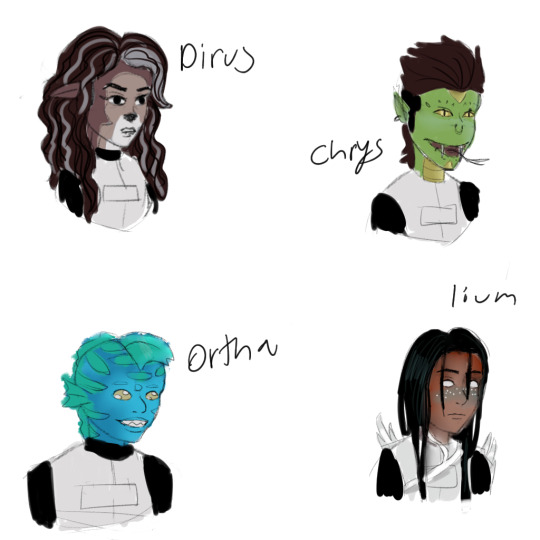
#generator rex#OCs#man of action#original character#evos#generator rex evos#original evo designs#providence search and rescue team
7 notes
·
View notes
Note
Those prehistoric merpeople definitely hold their own with the modern characters in the Magnificently Involved Dental Department. Orthacanthus looks especially tough on the doodling digits (though believe me it paid off).
It was! Trident-shaped teeth are HARD.
10 notes
·
View notes
Text
Xenacanthus
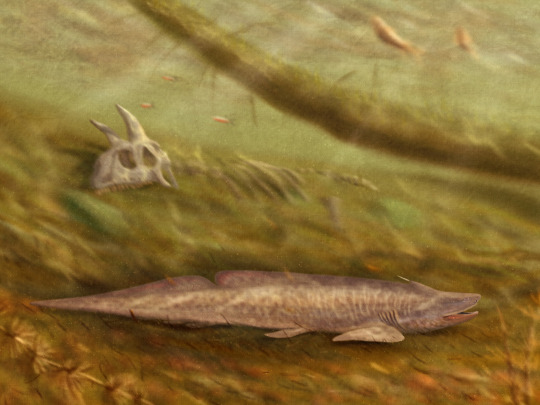
By @stolpergeist
Etymology: Weird spine
First Described By: Beyrich, 1848
Classification: Biota, Archaea, Proteoarchaeota, Asgardarchaeota, Eukaryota, Neokaryota, Scotokaryota, Opimoda, Podiata, Amorphea, Obazoa, Opisthokonta, Holozoa, Filozoa, Choanozoa, Animalia, Eumetazoa, Parahoxozoa, Bilateria, Nephrozoa, Deuterostomia, Chordata, Olfactores, Vertebrata, Craniata, Gnathostomata, Eugnathostomata, Chondrichthyes, Elasmobranchii, Euselachii, Selachimorpha, Xenacanthida, Xenacanthidae
Referred Species: X. atriossis, X. comrpessus, X. decheni, X. denticulatus, X. erectus, X. gibbosus, X. gracilis, X. howsei, X. indicus, X. laevissimus, X. latus, X. ludernensis, X. moorei, X. ossiani, X. ovalis, X. parallelus, X. parvidens, X. ragonhai, X. robustus, X. serratus, X. slaughteri, X. taylori
Status: Extinct
Time and Place: 295 to 208 million years ago, from the Sakmarian of the Early Permian to the Rhaetian of the Late Triassic.

In the Triassic, Xenacanthus is known from New Mexico, Texas, and India.
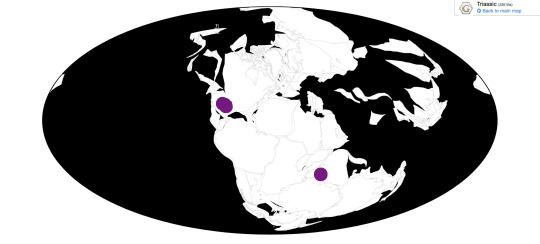
Physical Description: Xenacanthus gets its name from the very large and narrow spike protruding out of the back of its head. Seriously, what’s up with that. Nobody really knows. Besidse that, the thing most people talk about are its teeth. Xenacanthid teeth are distinctively-shaped: they had a large oval base with two prongs shooting out, making the tooth look V-shaped. But beyond this, Xenacanthus is still interesting. The body is long and shallow, with ribbonlike dorsal and caudal fins that form an almost continuous fin going down the back and back up the bottom of the animal. The pectoral and pelvic fins are short and very broad.
Diet: Xenacanthus’s bizarre teeth may hint at a diet of crunchier foods. It likely ate fish and small invertebrates in the waters it lived, as well as potentially the carcasses of anything that drowned.
Behavior: Xenacanthus’s body is not well-equipped for fast swimming. Its pectoral and pelvic fins almost look limblike, and may have potentially been used to help maneuver (or “walk”) around river bottoms like modern epaulette sharks. Xenacanthus likely sat in the muddy bottoms of the rivers it lived in, waiting for prey to swim on by. Although it lived in rivers, Xenacanthus may have migrated to the sea to spawn like its relative Orthacanthus (and some living eels). The purpose of the spike on the back of the head is completely unknown, but it may have been used for display, defense, or stabilizing swimming.
Ecosystem: Xenacanthus lived in shallow freshwater environment such as seasonal rivers. It’s known from two areas in the Triassic: the southwestern United States, and India. In the southwestern US, it lived alongside the lungfish Ceratodus, various ray-finned fish, temnospondyls such as Metoposaurus and Koskinonodon, early dinosaurs like Coelophysis, dinosauromorphs such as Dromomeron, pseudosuchians such as Typothorax, Shuvosaurus, Postosuchus and Poposaurus, phytosaurs such as Rutiodon and Smilosuchus, and various other bizarre archosauromorphs like Vancleavea, Trilophosaurus, and Tanytrachelos. If this sounds familiar, this is because we’ve already featured lots of critters from Late Triassic North America. Lots of familiar faces.
Meanwhile in India, Xenacanthus lived alongside the hybodontid shark Polyacrodus, Ceratodus again, and the temnospondyl Buettneria. These rivers would have been frequented by thirsty amniotes such as the rhynchosaur Hyperodapedon, the protorosaur Malerisaurus, aetosaurs, the early dinosaur Alwalkeria, dicynodonts, the cynodont Exaeretodon, and that weirdo, you know it, you love it, Shringasaurus.
Other: Xenacanthus evolved in the Permian, and amazingly made it through the Great Dying! Sure, they were a lot more common in the Permian, but xenacanthids made it through to the end of the Triassic (when they were apparently done in by the end-Triassic extinction).
~ By Henry Thomas
Sources under the cut
Beck, K.G., Soler-Gijon, R., Carlucci, J.R., Willis, R.E. 2014. Morphology and Histology of Dorsal Spines of the Xenacanthid Shark Orthacanthus platypternus from the Lower Permian of Texas, USA: Palaeobiological and Palaeoenvironmental Implications. Acta Palaeontologica Polonica 61(1): 97-117.
Bhat, M.S. 2015. A new and diverse Late Triassic fish assemblage from India. International Conference on Current Perspectives and Emerging Issues in Gondwana Evolution, Lucknow.
Lucas, S.G., Heckert, A.B., Hotton, N. 2002. The rhynchosaur Hyperodapedon from the Upper Triassic of Wyoming and its global biochronological significance. New Mexico Museum of Natural History and Science Bulletin 21: 149-156.
Palmer, D. 1999. The Marshall Illustrated Encyclopedia of Dinosaurs and Prehistoric Animals. Marshall Publishing, London.
Pauliv, V.E., Dias, E.V., Sedor, F.A., Ribeiro, A.M. 2014. A new Xenacanthiformes shark (Chondrichthyes, Elasmobranchii) from the Late Paleozoic Rio do Rasto Formation (Parana Basin), Southern Brazil. Anais da Academia Brasileira de Ciencias 86(1).
#xenacanthus#xenacanthid#shark#triassic#triassic madness#triassic march madness#prehistoric life#paleontology
157 notes
·
View notes
Text
Update Time: Dinosaurs and Prehistoric Animals In Mass Media
A while back, I did a post on my findings for Dinosaur Representation in Film. Thanks to a project I’ve been aiding with, I’ve been able to greatly expand my media intact. From what I could watch (excluding the Simpsons, because how the hell am I gonna ID prehistoric life that cartoony), here are the top 10 prehistoric animals of various groups I’ve been able to log until about March of this year. Youtube always puts out something new, so I had to cut off some things.
This covers Movies, TV Shows, Educational Shorts, Direct to Video productions, Youtube Channels, and Youtube videos (for not largely dedicated prehistoric channels/playlists). This involved a lot of IDing I had to do myself. So when a documentary showed a mural or sculpture, I did my best to either deduce or track down the thing so I could ID things properly. Crystal Palace and Age of Reptiles showed up a LOT.
I even counted background skeletons for various museum shots when I could. Because I was going ALL IN on this.
And things that used 60% stock footage were not counted to avoid repetition. That said, footage from The Lost World (1925) got used a LOT, like, into the 21st century even!
As a final side note: SCREW Trilobites! They’re almost never IDed, and there are 40,000 of them!
Here is what I found out:
Top 15 Dinosaurs:
Tyrannosaurus - 306
“Raptor” (Velociraptor (90), Deinonychus (91), and Dakotaraptor/Giant Movie Villain Raptor (56) combined) - 237
Triceratops - 223
Apatosaurus ((121) and Brontosaurus(99)) - 220
Stegosaurus - 181
Allosaurus - 164
Basic Ornithomimidae (Struthiomimus (48), Ornithomimus (42), Gallimimus (30), Dromiceiomimus (8), Pelicanimimus (5), Archaeornithomimus (1) Combined) - 134
Edmontosaurus/Anatosaurus/Anatotitan - 124
Brachiosaurus - 121
Parasaurolophus - 121
Ankylosaurus - 97
Diplodicus/Seismosaurus - 93
Iguanodon - 82
Pachycephalosaurus ((56), Stygimoloch (15), Dracorex (8), and Alaskacephale (1) combined) - 80
Coelophysis - 73
Top 10 Birds/Stem Birds/Avilalans
Archaeopteryx - 84
Hesperornis - 26
Giant Moa - 23
Titanis walleri - 22
Ichthyornis (and related) - 21
Gastornis - 20
Phorurhacos - 18
Confuciusornis - 18
Teratornis - 17
Haast’s Eagle - 15
Top 10 Non-Avian Line Archosaurs
Crocodiles, Alligators, Caiman (Lumped Together) - 32
Postosuchus - 31
Sarcosuchus - 26
Desmatosuchus - 25
Deinoschus - 22
Smilosuchus - 17
Rutiodon - 17
Erythrosuchus - 17
Teleosaurus - 15
Tanystropheus - 15
Top 15 Prehistoric Mammals
Woolly Mammoth - 99
Smilodon - 83
Neanderthals - 73
“Cave Man (Cro-Magnon) - 64
Australopithecus - 59
Columbian Mammoth - 41
Equus ferrus (wild horse/tarpan) - 37
Mastodon - 37
Megalonyx - 37
Homo erectus - 36
Woolly Rhino - 36
Glyptodon - 33
Megatheirum - 32
Dire Wolf - 31
Gigantopithecus (including Kong and knockoffs of Kong) - 31
Top 10 Synapsids
Dimetrodon - 81
Edaphosaurus - 30
Inostrancevia/Giant Gorgonopsids - 28
Gorgonops - 25
Diictodon - 23
Placerias - 22
Lystrosaurus - 21
Moschops - 16
Lisowicia - 15
Tie: Estemmenosuchus, Secodontosaurus, Sphenacodon - 14
Top 10 Ancient Lepisosaurs
Mosasaurus - 66
Megalania - 30 (I lumped many a Slurpasaurus in here)
Tylosaurus - 30
Titanoboa - 17
Prognathodon - 14
Gigantophis - 9
Plioplatecarpus - 9
Platecarpus - 8
Dallasaurus - 7
Tetrapodphis - 7
Regular Iguana’s come in at #11.
Top 15 Pterosaurs
Pteranodon - 153
Quetzalcoatlus - 87
Rhamphorhynchus - 55
Pterodactylus - 45
Dimorphodon - 38
Ornithocheirus - 25
Geosternbergia (was once considered a species of Pteranodon, but they are easy enough to distinguish) - 24
Anuragnathus - 24
Hatzegopteryx - 22
Nyctosaurus - 16
Eudimorphodon also has a 16, but I flipped a coin for this list.
Top 10 Ichthyosaurs
Ichthyosaurus - 37
Ophthalmosaurus - 26
Temnodontosaurus - 19
Sonisaurus - 15
Mixosaurus - 13
Shastasaurus - 10
Cymbospondylus - 9
Eurhinosaurus - 7
Stenopterygius - 7
Cartorhynchus - 7
Top 10 Other Aquatic Reptiles
Elasmosaurus - 64
Plesiosaurus - 47
Nothosaurus/”Paleosaurus” - 24
Pliosaurus - 19
Kronosaurus - 18
Liopleurodon - 16
Placodus - 12
Dolichorhynchops - 10
Cryptoclidus - 8
Placochelys - 7
Top 5 Turtles
Archelon - 21
Megalocheluys atlas/Giant Tortoises - 11
Proganocheys - 10
Odontochelys - 7
Carbonemys - 6
Top 5 Primitive Reptiles
Scutosaurus - 26
Hylomnus - 21
Drepanosaurus - 14
Mesosaurus - 10
Sharovipteryx - 9
Top ~10 Prehistoric Amphibians
Eryops - 38
Ichthyostega - 32
Tiktaalik - 23
Mastodonsaurus - 19
Koolasuchus - 16
Seymouria - 16
Metoposaurus - 15
Prionosuchus - 14
Platyhystrix - 14
Diplocaulus - 14
Acanthostega - 14
Crassigyrinus is just short of being in the grouping.
Top 15 Fish and Sharks
Coelacanths (modern (23), Mawsonia (16), Coelacanthus (7), Rebellatrix (5), and Axelrodichthys (2)) - 53
Dunkleosteus - 32
Megalodon - 31
Lungfish (combined modern species and Necroceratodus) - 28
Xiphactinus - 26
Eusthenopteron - 26
Helicoprion - 24
Bothriolepis - 22
Onchopristis - 17
Orthacanthus - 17
Cretoxyrhina - 16
Hybodus - 16
Cheirolepis - 16
Cepjhalaspis - 15
Arandaspis - 14
Top 10 Arthropods & related.
Meganeura/Meganeuropsis - 59
Arthropleura - 27
Megalograptus - 26
Pterygotus - 24
Horeshoe Crab - 19
“Giant Spiders” - 18
Eurypterus - 18
Marella/Marellamorpha - 16
Pulmonoscorpius (Giant scorpion) - 14
Aysheaia - 12
Top 10 Trilobites
Generic Unnamed/Unidentified Trilobites - 38
Phacops - 24
REdlichia - 23
Isotelus rex - 20
Elrathia - 14
Dicranurus - 8
Asaphus - 8
Terataspis - 7
Olenoides - 7
Paradoxides - 7
If you don’t count the generic one, then the last slot is a tie for Harpes and Oryctocephalus (at 5 appearances each).
Top 10 Mollusks
Ammonite (Generic) (Identifying the various species of Ammonite by sight is as hard as the Trilobites) - 54
Cameroceras - 22
Belemnites - 20
Orthoceras - 16
Wiwazia 16
Nautilus - 15
Parapuzosia - 10
Clam - 10
Inoceramus - 9
Tusoteuthis/Giant Squid - 6
Top 9 Super-Primitive Basal Animals
Charnia - 20
Kimberella - 10
Dinomischus - 9
Amiskwia - 5
Ernietta - 5
Funisia - 5
Coronacollina - 4
Swartountia - 4
Cyclomedusa - 4
29 notes
·
View notes
Note
prehistoric shark mer?

He’s based on an Orthcanthus!
Some little backstory to this.
While in the open water with his pod they were found out by some poachers in the ocean. He got some of his pod away say for a few younger pups and a few others trying to get them to swim downwards. He turned back to gather the rest and finally got the younger pups to swim down, though not without being speared through his tail and brought up.
While he was to be killed right away one of the crew members took notice of his appearance and ended up calling someone in. Of course, the crew just docked up and waited for the other person called. When they arrived they noted how it was definitely a he and was thought to be extinct species of mer, A Orthacanthus. While the poachers were going to kill him for a higher price the other mentioned person pulled some strings and brought the mer for an unknown high price.
Later on, taken to a zoo made for mers under research he has placed inside one of the largest tanks by far in the zoo. After being reviled to the public he was a fairly popular attraction. though needing a pod to properly thrive the workers are tracking down the aforementioned pod discovered by the poachers.
-------------
I may make a separate post, but this is just the gist of it.
Small facts to note
-Due to his odd appearance, he is falsely advertised as some sort of fortune-teller. Which has over the weeks in containment made him VERY disgruntled with humans.
-He still has the accessories he was found in, becoming rather aggressive if anyone dares to take them.
-While not outwardly hostile towards humans, he will swipe his tail around or hands. Though he is somewhat friendly towards the pups of theirs.
-He is a very old member of his grouping, which consists of only a few males and females and pups. Around fifteen in total
-He was part of a kingdom, which was destroyed millions of years ago.
-He is known to steal fish or attack any mer placed inside of the tank that is not his own. ((Though if smaller he will just leave them be-rarely))
-He will be friendly towards mers IF only they were placed in the tanks around him. Almost as if he was getting used to them.
#;;two sided mech- proctor spark case 🔮#;;Mermay#;;My art#//Forgive the lazy background! my hand startee to hurt!#//Hes not always going to be giving such a serious/grumpy face in my drawings I promise!#;;Spark Casr#;;My Art#;;Mermay verse
6 notes
·
View notes
Photo

Diving with Orthacanthus by HodariNundu . . . . . #monsterart #monsterartist #monsterarts #monster #monsters #characterart #characterartist #characterarts #creepy #creepyart #creepycreative #fantasyart #fantasycreature #fantasyartwork #fantasycharacter #FantasyLover #fantasyartcollection #fantasywork #fantasyconcept #fantasydesign #fantasyarts #digitalart #digitalartist #digitalartwork #digitalarts #digitalartists #digitalartworks #DigitalArtLook #digitalartistry #digitalartsociety
0 notes